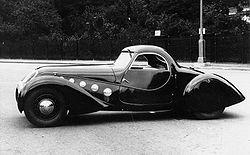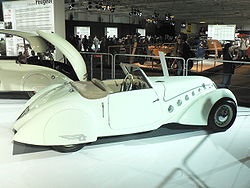
Peugeot 402
Encyclopedia



Sochaux
Sochaux is a commune in the Doubs department in the Franche-Comté region in eastern France.-Population:Inhabitants are known as Sochaliens.-Economy:...
, France
France
The French Republic , The French Republic , The French Republic , (commonly known as France , is a unitary semi-presidential republic in Western Europe with several overseas territories and islands located on other continents and in the Indian, Pacific, and Atlantic oceans. Metropolitan France...
from 1935 to 1942 by Peugeot
Peugeot
Peugeot is a major French car brand, part of PSA Peugeot Citroën, the second largest carmaker based in Europe.The family business that precedes the current Peugeot company was founded in 1810, and manufactured coffee mills and bicycles. On 20 November 1858, Emile Peugeot applied for the lion...
. It was unveiled in Paris Motor Show in 1935, replacing the Peugeot 401
Peugeot 401
The Peugeot 401 was a mid-size model from Peugeot produced in 1934 and 1935. It was introduced at the 1934 Paris Motor Show and continued to be offered until August 1935.-Details:...
.
The Peugeot 403
Peugeot 403
The Peugeot 403 is a car produced by French automobile manufacturer Peugeot from 1955 to 1966.-History:The 403 made its debut in saloon body style on 20 April 1955 at the Trocadéro Palace in Paris...
, introduced approximately thirteen years after the demise of the 402, can be seen as the older car’s natural heir. (Immediately after World War II
World War II
World War II, or the Second World War , was a global conflict lasting from 1939 to 1945, involving most of the world's nations—including all of the great powers—eventually forming two opposing military alliances: the Allies and the Axis...
the market demanded smaller cars: Peugeot acknowledged this by concentrating during the late 1940s and early 1950s on their 202
Peugeot 202
The Peugeot 202 was an automobile from Peugeot. Production of the car ran between 1938 and 1942 and then, after a brief production run of 20 in early 1945, restarted in mid-1946...
and 203
Peugeot 203
The Peugeot 203 is a medium sized car which was produced by the French manufacturer Peugeot between 1948 and 1960.The car was exhibited at the Paris Motor Show in 1947, but by then had already been under development for more than five years...
models.)
A conservative innovator
The 402 was characterized by what became during the 1930s a "typically Peugeot" front end, with headlights well set back behind the grille. The style of the body was reminiscent of the Chrysler AirflowChrysler Airflow
The Chrysler Airflow is an automobile produced by the Chrysler Corporation from 1934-1937. The Airflow was the first full-size American production car to use streamlining as a basis for building a sleeker automobile, one less susceptible to air resistance...
, and received in France the soubriquet Fuseau Sochaux which loosely translates as "Sochaux rocket". Streamlining
Streamliner
A streamliner is a vehicle incorporating streamlining in a shape providing reduced air resistance. The term is applied to high-speed railway trainsets of the 1930s to 1950s, and to their successor "bullet trains". Less commonly, the term is applied to fully faired recumbent bicycles...
was a feature of French car design in the 1930s, as can be seen by comparing the Citroën Traction Avant
Citroën Traction Avant
The Citroën Traction Avant is an automobile which was produced by the French manufacturer Citroën from 1934 to 1957. About 760,000 units were produced.-Impact on the world:...
or some of the Bugatti models
Bugatti Type 57
The Bugatti Type 57 and later variants was an entirely new design by Jean Bugatti, son of founder Ettore. Type 57s were built from 1934 through 1940, with a total of 710 examples produced....
of the period with predecessor models
Citroën Rosalie
The original Citroën Rosalie was a light-weight racing car that established a succession of records at the Montlhéry racing circuit. More generally the Rosalie was a range of three models/sizes of automobile that comprised the core of Citroën's model range between 1932 and 1938...
: Peugeot was among the first volume manufacturers to apply streamlining to the extent exemplified by the 402 and smaller Peugeot 202
Peugeot 202
The Peugeot 202 was an automobile from Peugeot. Production of the car ran between 1938 and 1942 and then, after a brief production run of 20 in early 1945, restarted in mid-1946...
in a volume market vehicle range.
Recessed ‘safety’ door handles also highlighted the car’s innovative aspirations, as did the advertised automatic transmission and diesel engine options. Comparisons with Citroën's large family car
Citroën Traction Avant
The Citroën Traction Avant is an automobile which was produced by the French manufacturer Citroën from 1934 to 1957. About 760,000 units were produced.-Impact on the world:...
of the time were and remain unavoidable. In that comparison, the basic underpinnings of the 402 remained conventional, based on known technologies, and presumably were relatively inexpensive to develop and manufacture: it was Citroën
Citroën
Citroën is a major French automobile manufacturer, part of the PSA Peugeot Citroën group.Founded in 1919 by French industrialist André-Gustave Citroën , Citroën was the first mass-production car company outside the USA and pioneered the modern concept of creating a sales and services network that...
that in 1934 had been forced to sell its car manufacturing business to its largest creditor
Michelin
Michelin is a tyre manufacturer based in Clermont-Ferrand in the Auvergne région of France. It is one of the two largest tyre manufacturers in the world along with Bridgestone. In addition to the Michelin brand, it also owns the BFGoodrich, Kleber, Riken, Kormoran and Uniroyal tyre brands...
. Sticking to a traditional separate chassis configuration also made it much easier for Peugeot's 402 to be offered with a wide range of different bodies.
The range
Even by 1930s standards, the range of different 402 models based on the single chassis was large, comprising by one estimate sixteen different body types, from expensive steel bodied convertible cars, to family saloons which were among the most spacious produced in France. There were three different standard wheelbases of 2880 mm (113.4 in) (short), 3150 mm (124 in) (used on the standard 4850 mm (190.9 in) long saloon) and 3300 mm (129.9 in) (long).The standard bodied saloon, first presented at the Paris Motor Show in the Autumn of 1935 was advertised as a six-seater. As volume production got under way, the range was complemented by coupe and cabriolet versions. A lengthened wheelbase supported the eight-seater 402 Familiale with dickey seats
Rumble seat
A rumble seat, dicky seat, dickie seat or dickey seat is an upholstered exterior seat which hinges or otherwise opens out from the rear deck of a pre-World War II automobile, and seats one or more passengers. An 1899 Century Dictionary describes a rumble as " A seat for servants in the rear of a...
.
A hugely expensive cabriolet version was the 402 Éclipse Décapotable, featuring the first powered retractable hardtop which had been designed, and in 1931 patented, by Georges Paulin
Georges Paulin
Georges Paulin was a dentist, part-time automobile designer and hero of the French Resistance during the Second World War. He was born 1902 in a working class section of Paris....
. Interest in the Éclipse resurfaced with the reintroduction of the retractable hardtop by the 1995 Misubishi 3000GT Spyder
Mitsubishi GTO
The Mitsubishi GTO is a sports car built by Japanese automaker Mitsubishi Motors between 1990 and 2001. In most export markets it was rebadged as a Mitsubishi 3000GT. It was also sold by Chrysler in North America as a Dodge Stealth captive import from the 1991 to 1996 model years with only minor...
and subsequent popularization of the concept by cars such as the Mercedes-Benz SLK-Class
Mercedes-Benz SLK-Class
The SLK is a compact roadster manufactured by Mercedes-Benz in three generations; R170 launched in 1996, the R171 in 2004 and R172 in 2011....
. Peugeot re-publicized the Éclipse Décapotable with the 2001 introduction of its 206 CC
Peugeot 206
The Peugeot 206 is a supermini car, manufactured by the French automaker Peugeot from 1998 to 2010.Even though the 206 has finished production in most markets as of 2010, in Europe since 2009, it is available the 206+, with a back and especially a front design that resembles the Peugeot 207.-The...
retractable hardtop two-seater.
The retractable roof system was incorporated into various low volume Peugeot cabriolets in the 1930s, assembled by Émile Darl'mat’s
Darl'mat
Emile Darl'mat was the creator and owner of a Peugeot distributor with a car body business established at the rue de l'Université in Paris, France in 1923. In the 1930s the firm gained prominence as a low volume manufacturer of Peugeot based sports cars...
Paris based Peugeot dealer and coachwork business — which also produced aerodynamic sports coupé 402s following the line of the coach builder’s own body for the Bugatti Type 57 Atlantic
Bugatti Type 57
The Bugatti Type 57 and later variants was an entirely new design by Jean Bugatti, son of founder Ettore. Type 57s were built from 1934 through 1940, with a total of 710 examples produced....
.
First exhibited on October 1937, the shortened 402 Légère (light weight) was effectively the body of a Peugeot 302
Peugeot 302
The Peugeot 302 is a mid-weight saloon introduced in 1936 Paris Motor Show by Peugeot and sold until 1938.-Background:The 302 was effectively a shortened version of the Peugeot 402 with a smaller engine...
persuaded onto the chassis of the newer 402. With an advertised top speed of 135 km/h (84 mph), the Légère was considered particularly fast for its class.
Light commercial van and utility variants of the 402 were also produced, and during the car’s final years, during World War II
World War II
World War II, or the Second World War , was a global conflict lasting from 1939 to 1945, involving most of the world's nations—including all of the great powers—eventually forming two opposing military alliances: the Allies and the Axis...
, assumed increasing prominence within the range. Sources vary as to whether production was ended it 1942 or continued further, possibly till 1944.
The engine
The car was launched with a four-cylinder water-cooled engine of 1991 cc with poppet valvePoppet valve
A poppet valve is a valve consisting of a hole, usually round or oval, and a tapered plug, usually a disk shape on the end of a shaft also called a valve stem. The shaft guides the plug portion by sliding through a valve guide...
. Claimed maximum output was 55 PS at 4000 rpm. With 55 PS the car could achieve top speed of 120 kilometre per hour. In 1938 the capacity was raised to 2142 cc with the introduction of the Peugeot 402B, stated output now being 60 PS. Given the wide range of body lengths and styles offered, there was and is correspondingly wide range of different performance figures quoted for the standard-engined 402.
Other engine versions existed, with a claimed output of 70 bhp for a Darl'mat bodied performance coupe version.
A 2.3 L Diesel engine was also developed which would have made the 402 one of the very first diesel
Diesel engine
A diesel engine is an internal combustion engine that uses the heat of compression to initiate ignition to burn the fuel, which is injected into the combustion chamber...
saloons available commercially: approximately twelve diesel 402s were constructed but the outbreak of war prevented the introduction of the 402 diesel to the market. The development work was not wasted, however, and in 1959 Peugeot would launch one of the world's earlier diesel powered saloons
Peugeot 403
The Peugeot 403 is a car produced by French automobile manufacturer Peugeot from 1955 to 1966.-History:The 403 made its debut in saloon body style on 20 April 1955 at the Trocadéro Palace in Paris...
, albeit beaten to the market by Mercedes Benz.
Running gear
Standard transmission was a three-speed manual system, driving through the rear wheels.The option of a Cotal three-speed automatic was offered, but this was an elaborate system more commonly seen on upmarket models from the likes of Delahaye
Delahaye
Delahaye automobile manufacturing company was started by Emile Delahaye in 1894, in Tours, France. His first cars were belt-driven, with single- or twin-cylinder engines. In 1900, Delahaye left the company.-History:...
and Delage
Delage
Delage was a French luxury automobile and racecar company founded in 1905 by Louis Delage in Levallois-Perret near Paris; it was acquired by Delahaye in 1935 and ceased operation in 1953.-History:...
. It was too expensive to appeal to 402 buyers.
Stopping the car was achieved using cable operated drum brakes: cable-operated brakes were by this time regarded as an old technology which compromised the innovative image presented by other aspects of the 402.
Commercial
Approximately 75,000 402s were produced during the seven or more years of production. It took Peugeot from the 1930s to the 1940s, covering two decades that saw a dramatic reduction in the number of automakers in France. Of the survivors, CitroënCitroën
Citroën is a major French automobile manufacturer, part of the PSA Peugeot Citroën group.Founded in 1919 by French industrialist André-Gustave Citroën , Citroën was the first mass-production car company outside the USA and pioneered the modern concept of creating a sales and services network that...
was taken over by a tyre/tire company in the 1930s: Renault
Renault
Renault S.A. is a French automaker producing cars, vans, and in the past, autorail vehicles, trucks, tractors, vans and also buses/coaches. Its alliance with Nissan makes it the world's third largest automaker...
was nationalised in the 1940s. Peugeot survived and retained its independence.
France declared war on German in 1939 and after this date cabriolet and convertible versions of the 402 disappeared from the price lists. The April 1940 price list shows only the standard bodied and long wheelbase saloons. Peugeot only became a regular supplier to the army in 1938, but during 1939 and 1940 several thousand 202s and 402s were operating with the armed services, the long wheel base 402 being a particular military favourite.

